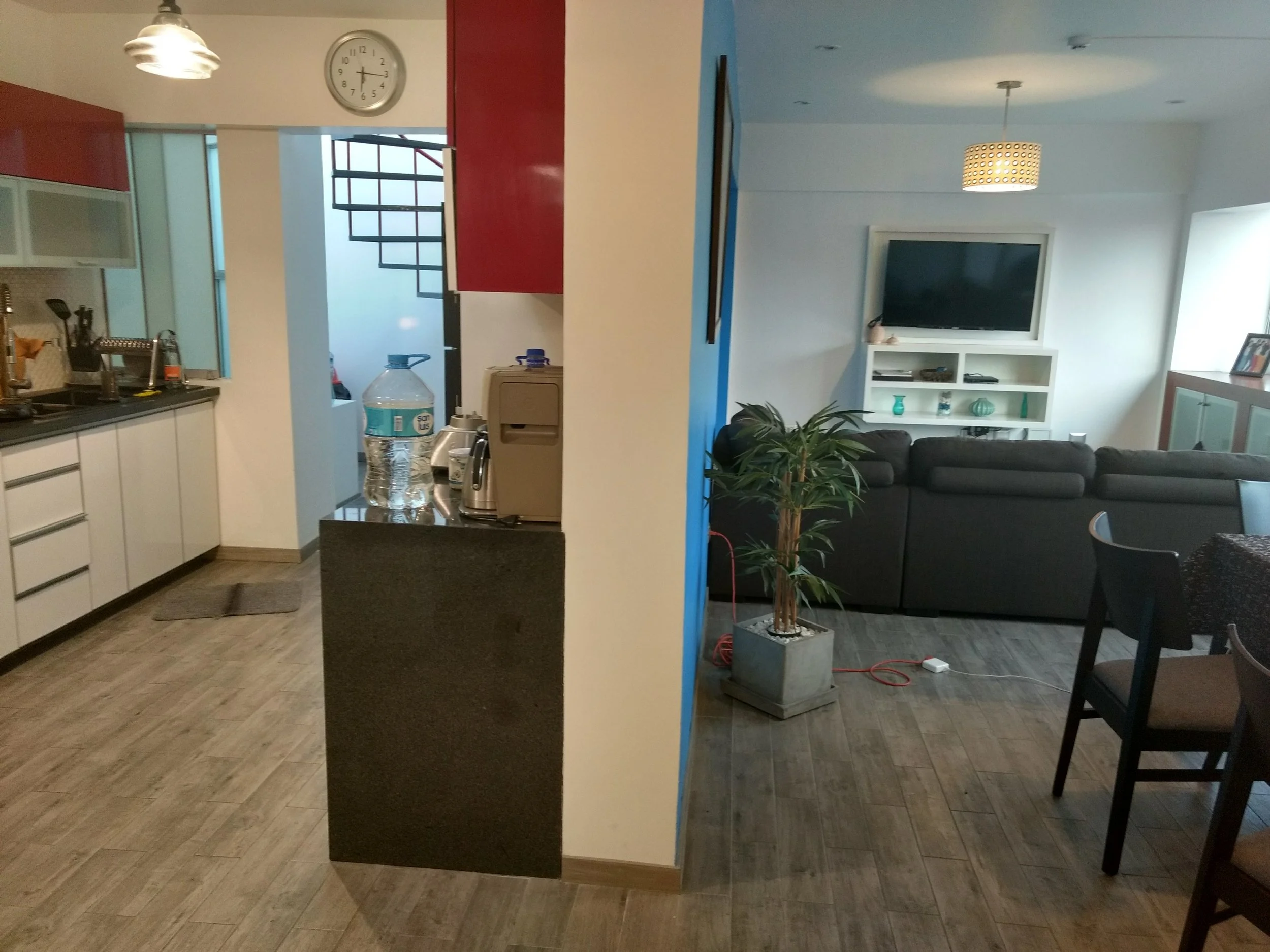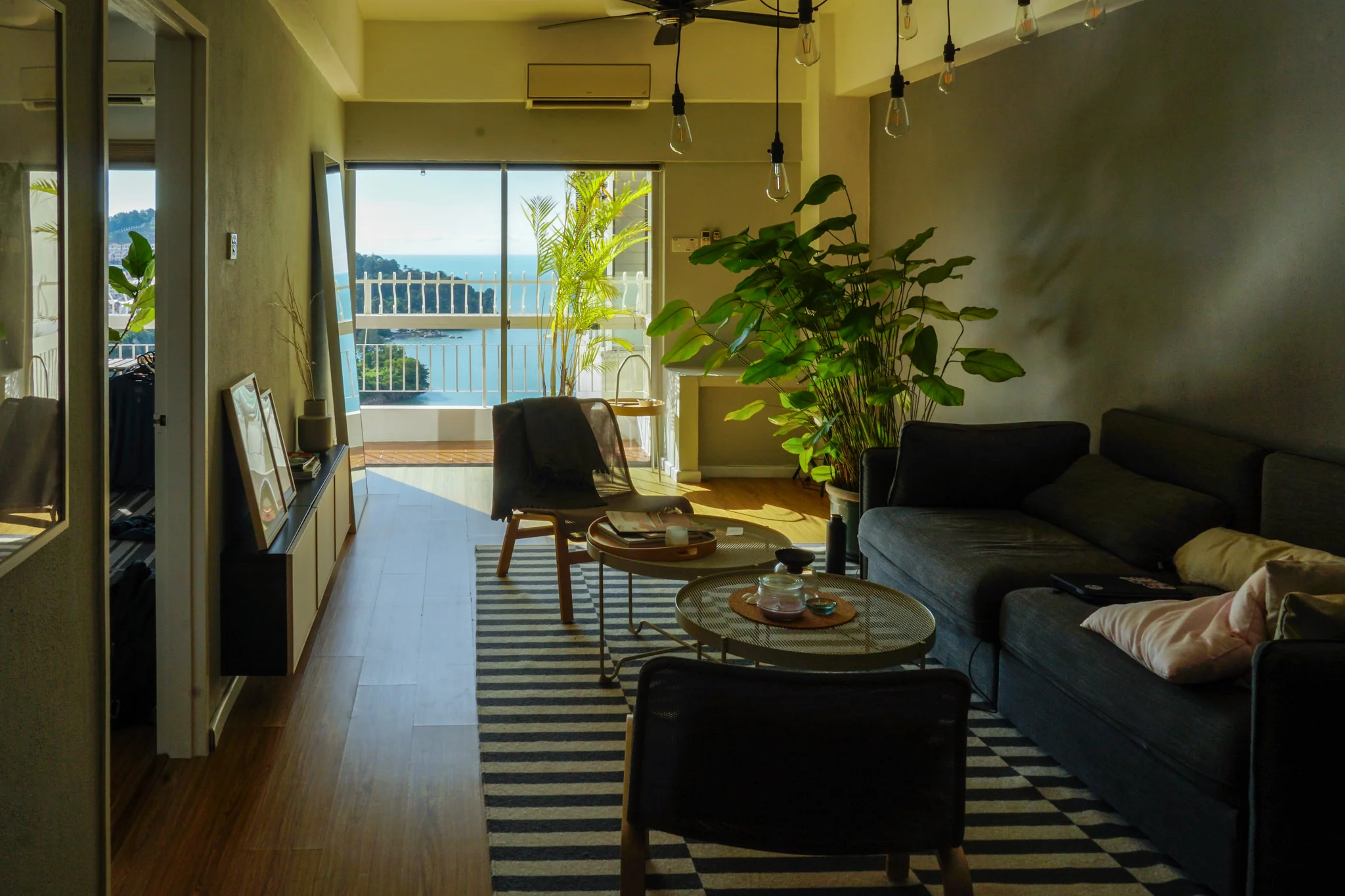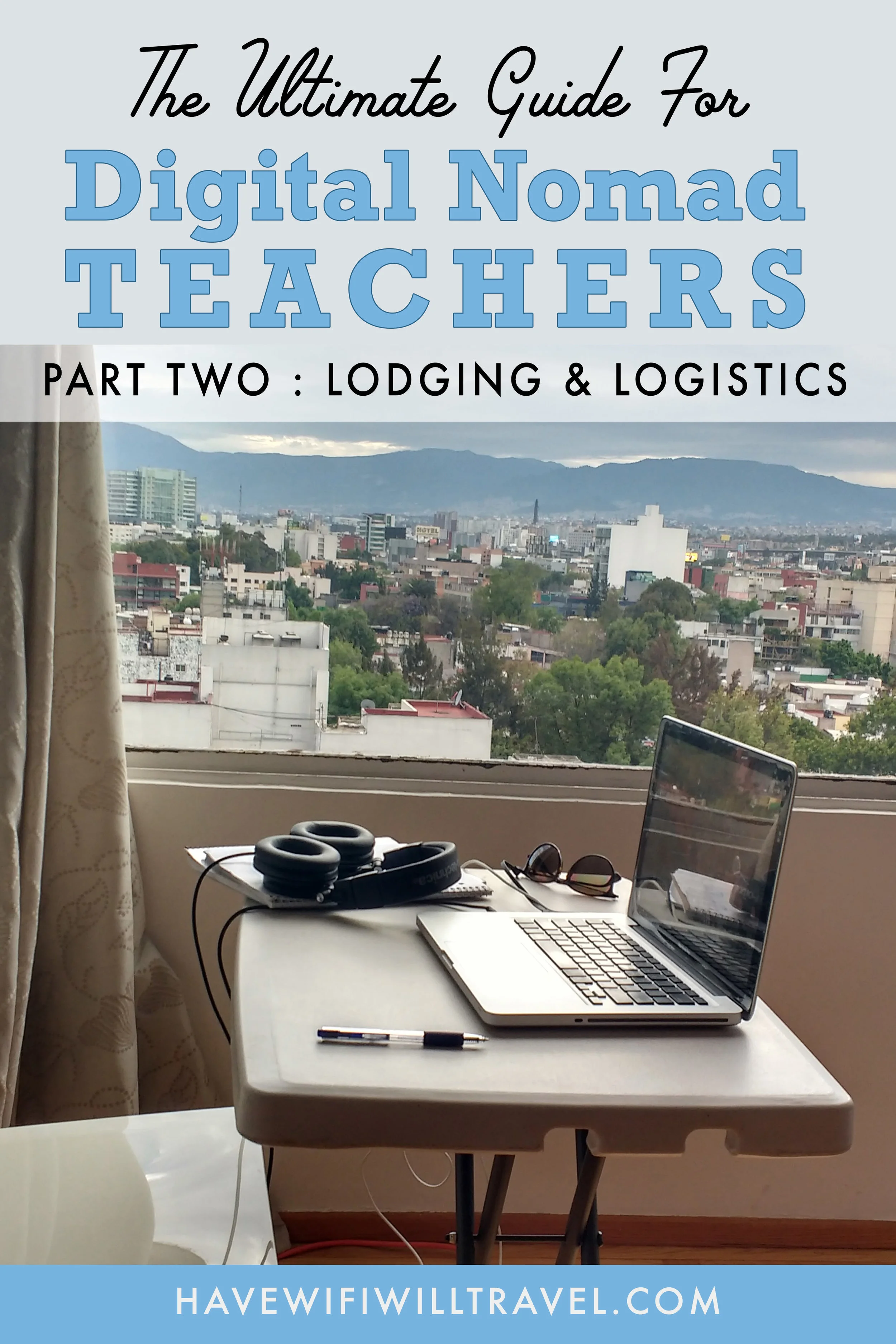The Ultimate Digital Nomad Teacher Guide Part II: Lodging, Managing your Schedule & Logistics
Once you decide to become a travelling teacher you no longer really fall into the category of merely a “traveller,” or “backpacker.” Now, you can consider yourself a “digital nomad.”
You plan to work while you travel, explore and have epic adventures. When you must juggle the life of an explorer with the life of a teacher, you should fully consider your options for accomodations.
For technology and internet hacks for teachers; see the first guide here (The Ultimate Digital Nomad Teacher Guide–Part One: Technology & Gear)
Finding your home base: Rentals, hotels & housing
My first choice: apartment rentals:
Because we travel as a couple, we tend to only rent 1 or 2-bedroom apartments and avoid studios and hotel rooms. We rent a 1-month minimum average to take advantage of low monthly rates and allow for a more relaxed work schedule.
If you give yourself a budget of $600USD/month for singles and $800/couples, you’ll be able to find a nice studio and even a 1 or 2 bedroom apartment with kitchenette and private bathroom in many parts of the world. This equals about $20-25/night. You’d be hard pressed to find an equally as decent hotel room or private room in a dorm for that price–and the chances of getting good internet are much higher with a private space. We find that when we have a kitchen we also can save on eating out and also stay healthier by cooking at home more often.
Our little loft in Hualien, Taiwan for $700/month. We found in on Airbnb.
Our massive 2 bedroom, 3-story apartment in the Barranco neighborhood of Lima. This was easily one of our favorite rentals ever, and also our most expensive at $1100/month.
Filters:
When searching you can filter your options to help you narrow down rooms.
We search for rooms by the month so we can see the monthly discounts (they are often quite good).
Try switching on the “For work” option under “trip types.” This will give you Airbnbs that are equipped for business travellers–wifi, workspaces, etc. Keep in mind: this will narrow down your options quite a bit, but it’s worth a peak.
Home Type: “Entire Place” or “Private Room” only here!
If not using “for work” filter, I will use the “wifi” and “private workspace” filters.
Communication with your host:
ALWAYS send a message to your host before booking. My message usually goes something like this:
Hello (HOST NAME)
I’m looking at staying (AMOUNT TIME) in (LOCATION). Your apartment/house/room looks very nice, I love (SPECIFIC THING I LIKE)! I am an online teacher, so I will need to do some bandwidth-heavy video calls & for my job during that time and need to be able to work online regularly. For this reason, I require a stable internet connection.
Some important questions before I commit: How is your internet (what speeds do you get)? Is there a private router, or is it a shared connection? Am I able to connect to the router with my ethernet cord or just wifi? Is there a place in the rental where I can work at such as a desk or table?
Thanks so much,
(YOUR NAME)
If you plan to rent a private room in a shared apartment, you’ll also need to ask a few additional questions such as–will I bother anyone if I teach at (EARLY OR LATE TIME)? And, How many people are sharing the internet during my teaching time?
What about a hostel?
I would never recommend staying in a dorm at a hostel if you plan on teaching. Fork over a little more money (you have a job after all!) and get a private room–I promise it will be more profitable in the end because you will feel better about teaching more classes.
You may be able to get away with hostels if you try the 4 on-3 off schedule I describe below. Stay in a private space 4 days a week while you teach, then spend 3 nights in a hostel, on your off days. However, keep in mind, this gets exhausting fast.
Consider this: You are likely to annoy your fellow hostel guests with your loud rendition of the “Hello Song.” Save hostels for side trips. Unless you can find the perfect 24-hour coworking space nearby with private skype rooms, I would never stay in a hostel. I spent over a year living in hostel dorms, as a backpacker, and I cannot imagine adding teaching or any job to that lifestyle.
Workspace in our private room airbnb in Mexico City. This was the last time we rented a private room. My early morning classes bothered our hosts. This is why clear communication with your host is so important.
Money saving tips:
Book a month or longer for discounts.
Most places offer discounts for 1 week and more for 1 month. As a general rule: the more you hop around, the more expensive it will be.
Find a host on Airbnb, then look them up on google and book independently.
Look for clues about the building name in the host information or even in the description. Search on google and contact the host directly. This way you can find a highly rated host but skip the Airbnb fees. We’ve managed to do this several times and got great deals on places. Many places list their properties on several different booking sites and even have their own private page.
Inquire about rentals on facebook groups such as Digital Nomad Teachers.
Then contact the recommended host directly.
Join local expat Facebook groups
Seek out and join Facebook groups for your desired destination or look specifically for housing groups. We’ve found a few of our cheapest rentals this way.
Our lovely seaside apartment in Penang Malaysia; huge 2-bedroom place for $650/month, with great internet for teaching. We found it listed on a Facebook group for Digital Nomads.
Teaching From Hotels:
Hotels are a step above hostels, though still a risky option. Much like hostels, you’ll need to be concerned about sharing a router with multiple users, consider the distance from the router, and ensure you have a space for teaching. I find that hotels that have facilities for business travelers are best. I have had luck teaching from hotels that offer a desk and ethernet connection in the room. Contact the hotel ahead of time to verify an ethernet port and bring your ethernet cable!
Coworking and Coliving Spaces:
These are spaces which you pay to use in exchange for fast internet, decent facilities and if you’re lucky, a private space for making video calls (ie teaching classes). In my early days of teaching online in early 2015, I used coworking spaces far more often than I do now. Now that I’ve become more skilled at finding apartments or rentals with good wifi, I don’t use them as often. Unfortunately, very few coworking spaces are appropriate for teaching online. Jim and I have often talked about starting a coworking space just for online teachers–”Teach On The Beach” Coming Soon?
Daily group breakfasts with new friends at Sun Desk, in Taghazout Morocco. Here you can book daily-weekly-monthly coliving or coworking for a reasonable price. Perks include good wifi, support, and plenty of social engagements.
Tips for using coworking spaces:
Always contact the manager first and ask about the possibility of teaching in the space. Ask about ethernet hookups and if there is a private room/skype room to teach your online classes. Be honest about the nature of the job–it’s noisy, you need privacy etc.
Never teach from public spots in the space where you may disturb other digital nomads at work.
Find out about operating hours to ensure the coworking space is open during the time you plan to teach.
Ensure use of call rooms does not cost extra.
House Sitting
Here’s the ultimate money saving Digital Nomad hack–get into house sitting! Stay at other peoples beautiful homes, with their cute pets for FREE. While we are not house sitters ourselves, we’ve talked about doing this for years, and know other Digital Nomad teachers who save loads of money by choosing their destinations based on house sits. Check out this article, for a comprehensive overview.
Setting up your portable classroom:
Now not every online classroom teacher will see the value in this. However, as a teacher trainer and mentor for VIPkid, I’ve been trained to emphasize this and have insight into the importance of portraying yourself to students and parents in a professional manner.
Many parents will directly judge you based on how professional you appear. If you look like a dirty backpacker, in a dark and noisy corner, you simply won’t get as many rebooks. Part of this is making sure you have not only an appropriate space for teaching but a space that has been optimized for teaching.
Step One:
Find a blank wall and situate yourself so the wall is behind you. Make sure there are no windows or glaring light sources on this wall. It’s ideal if you can have a nice window in front of you. Find someplace quiet, private and free from distractions.
Step Two:
Get your light sources in order. It’s best if you can have 3 different lights: Overhead light, lighting directly in front of your face and a window with natural light–and if this is not possible, another lamp place on the other side of your computer.
Step Three:
Hang up something on the wall behind you. A clear name tag, a map, an educational poster. I bring sticky tack with me so I can hang things up and make a temporary classroom wherever I may be. Some teachers might bring a tapestry so they can have more flexibility about what they can turn into a classroom.
Viola! You’re almost ready to teach!
Balancing multiple schedules:
My best advice is to start slow. Depending on the time zone you are visiting and what that means for your lesson schedule, you may want to play around with a few different schedules. You’ll want to be mindful of burnout. Remember, traveling itself is tiring, add teaching into that and you’ll exhaust yourself quickly if you’re not careful.
Determine your minimum salary & start slow:
Decide the minimum you’ll need to make to get by and start with that. I’ve discovered my minimum, for most locations, is around $1500 a month. Divide that amount by your hourly rate and that will give you your minimum hours–divide that by 4 and you’ll have an idea of our many hours you have to make to get by. Your first 2-3 weeks, aim for that minimum. If you’re comfortable, work your way up to more hours. If you have a busy travel week, stick to the minimum.
For example:
Rent = $400-600/month
Food Costs= $100/week, ie $400 month
Fun Money= $200/month
Travel Expenses=$400/month
-------------------------------------
Total Minimum Salary= $1400-1600/month
$1600 divided by $26/hour = 61 hours divided by 4(weeks) = about 15.5 or 16 hours a week minimum
For me, as I average around $26 an hour, this means I know I need to book and complete around 62 hours of teaching per month. Or 16 hours a week minimum. I tend to aim for 25-30 hours most weeks ($2500-3000/month) so I can save money. Beginner online teachers often start out making a bit less, so keep that in mind if you’re new.
Start with an inexpensive destination:
For your first time teaching while traveling, choose a country with a low cost of living. Southeast Asia is perfect for beginner Digital Nomad teachers. Countries like Thailand, Malaysia, and Vietnam, are inexpensive, filled with fellow nomads, and tend to have decent internet. You can easily get by on a budget of $1000 or less per month. Keep an eye on cheap flights to Asia so airfare doesn’t break your budget. Other inexpensive places good for travelling teachers in the Western Hemisphere include Mexico, Peru, and Colombia. Just be aware the internet situation is more complicated in Latin America.
Schedule Smart:
Prior to arriving in a new destination, avoid scheduling classes ahead of time. I typically wait until I’ve arrived in order to assess the situation; check up on the internet, buy a local SIM card, figure out the best working hours for that location, etc. Once you’ve arrived at your first destination and you’re starting to offer your availability, you can consider your schedule.
Consider some options:
4 days on, 3 days off– Booking busy teaching schedules for 4 days, then take 3 solid days off. This allows time for travel days, rest days and exploration. This is my go-to schedule.
A little bit everyday– Book a couple hours every morning (or every evening), but take the remainder of the day off. Once a month, every month take off 3-5 consecutive days and have an adventure without your computer.
Every other week– busy/slow/busy/slow. Can be nice for fitting in longer trips, but can be challenging for maintaining student schedules.
Resources:
*New to Airbnb?
Use my referral link and receive a discount on your first booking. Think of it as a way of thanking me for this informative article while saving a few bucks yourself.
*Want to teach online but haven’t got the job yet?
I work for VIPKid and I’m happy to offer a 1-hour skype coaching session for serious candidates who use my referral link. I’ve been training new teachers for the company for over 3 years and I can increase the likelihood of passing the training process: contact me for more information, and apply here.
Reach Out
Any online job can be isolating, especially when you’re in constant motion. Luckily you’re in good company–there are thousands of traveling teachers. You just need to find each other !
Join social media groups:
Search for local expat or nomad groups specific to the part of the world or country you plan on visiting. Join the groups to learn about meetups, events and to get in contact with people. This is also a great place to ask questions and learn about internet/data/etc.
These are all on Facebook:
VIPkid teachers who travel
Online Digital Nomad Teachers
Digital Nomads Around The World







